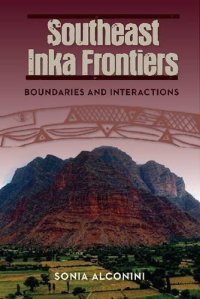
Ebook: Southeast Inka Frontiers: Boundaries and Interactions
Author: Sonia Alconini
- Tags: Native American, Americas, History, Peru, South America, Americas, History, Incan, Ancient Civilizations, History, General, Anthropology, Politics & Social Sciences, Archaeology, Politics & Social Sciences
- Year: 2016
- Publisher: University Press of Florida
- Language: English
- pdf
“An important contribution to the study of ancient empires and processes of imperial expansion through an in-depth study of the southeastern Inka frontier in current-day Bolivia.”—Elizabeth N. Arkush, author of Hillforts of the Ancient Andes: Colla Warfare, Society, and Landscape
“A fascinating case study of interactions on an imperial frontier in a region that is unfamiliar to many archaeologists. The attention to the role of the peoples on the other side of the frontier is particularly welcome.”—Peter S. Wells, author of How Ancient Europeans Saw the World: Vision, Patterns, and the Shaping of the Mind in Prehistoric Times
Imperial frontiers are a fascinating stage for studying the interactions of people, institutions, and their environments. In this volume, Sonia Alconini examines a part of present-day Bolivia that was once a territory at the edge of the Inka empire. Along this frontier, the Inka, one of the New World’s most powerful polities, came into repeated conflict with tropical lowland groups like the Gauraní-speaking Chiriguano. In response, the Inkas constructed a militarized frontier, which has for the most part been oversimplified in ethnohistorical accounts that frequently portray the Inka as a civilized empire resisting invasion by “savage and barbarian” groups.
Using extensive field research, Alconini explores the modes of direct contact between the Inkas and eastern tropical lowland populations, a situation often overlooked in studies of the area. Combining regional- and household-level perspectives, she studies the empire’s impact on local settlements as well as on domestic economy, production, cultural materials, and labor organization. She recognizes the frontier as a nexus between Inka, local, and lowland populations, describing the broader multifaceted socioeconomic processes occurring across the territory. This unprecedented study shows how the Inka empire exercised control over vast expanses of land in a location hundreds of miles away from the capital city of Cusco and how people on the frontier navigated the cultural and environmental divide that separated the Andes and the Amazon.
“A fascinating case study of interactions on an imperial frontier in a region that is unfamiliar to many archaeologists. The attention to the role of the peoples on the other side of the frontier is particularly welcome.”—Peter S. Wells, author of How Ancient Europeans Saw the World: Vision, Patterns, and the Shaping of the Mind in Prehistoric Times
Imperial frontiers are a fascinating stage for studying the interactions of people, institutions, and their environments. In this volume, Sonia Alconini examines a part of present-day Bolivia that was once a territory at the edge of the Inka empire. Along this frontier, the Inka, one of the New World’s most powerful polities, came into repeated conflict with tropical lowland groups like the Gauraní-speaking Chiriguano. In response, the Inkas constructed a militarized frontier, which has for the most part been oversimplified in ethnohistorical accounts that frequently portray the Inka as a civilized empire resisting invasion by “savage and barbarian” groups.
Using extensive field research, Alconini explores the modes of direct contact between the Inkas and eastern tropical lowland populations, a situation often overlooked in studies of the area. Combining regional- and household-level perspectives, she studies the empire’s impact on local settlements as well as on domestic economy, production, cultural materials, and labor organization. She recognizes the frontier as a nexus between Inka, local, and lowland populations, describing the broader multifaceted socioeconomic processes occurring across the territory. This unprecedented study shows how the Inka empire exercised control over vast expanses of land in a location hundreds of miles away from the capital city of Cusco and how people on the frontier navigated the cultural and environmental divide that separated the Andes and the Amazon.
Download the book Southeast Inka Frontiers: Boundaries and Interactions for free or read online
Continue reading on any device:

Last viewed books
Related books
{related-news}
Comments (0)